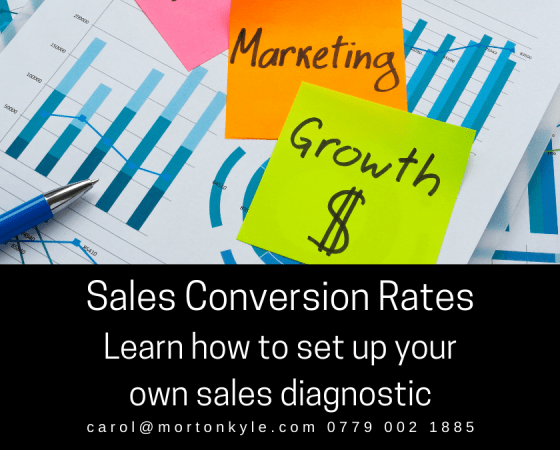Sales Conversion Rates
Lots of sales leaders and sales people monitor their sales conversion rates since it’s a good top line indicator in terms of converting the ‘potential opportunity’ to the ‘actual order’.
It’s asset utilisation at the starting point for sales – whether that’s a marketing campaign, a cold outreach, event attendee or an inbound via the website.
Sales conversion rates can be looked at as a whole sales function, a region, unit, per person, per product line and any other combination there of.
It’s easy to track – simple to view – up, down, same. Reported in sales teams far and wide.
And an easy number to explain to others not directly involved with the sales day to day ups and downs,
Sales Conversions Rates – The Most Under Utilised Sales Metric?
I think they are…here’s why…
Your Sales Conversion Rates, whether you are a sales person or a sales leader, informs you how you are using your most precious money making commodity….your time.
Coupled with sales velocity, your sales conversion rate predicts how fast the money is going to hit the bank.
And anything that allows you to predict future cash flow in sales is worth watching.
Very closely.
So, preparing sales forecasts, cash flow projections and the sort of stuff that banks, advisors, investors and executive teams want to see becomes simple and accurate.
Combine this with a time series data collection and forecasting becomes easier. Peaks and troughs easier to understand, explain or remedy.
And the most important sales improvement benefit? It forces accountability back into the team and off the sales leaders desk.
So far so good?
But that’s not all…it gets better.
Change Your Focus and See Where You Can Also Use Sales Conversion Rates
Your sales process, documented and detailed, rigid or flexible, will have certain gates in it.
These will be go/no go gates – easy ways to decide if a deal is worth progressing with or if you need to drop it. These sales gates will exist at every step in the sales process
Put a sales conversion rate at each gate – and a reason for making the go/no go decision – it’s the simples way to force a diagnostic into your sales process.
Such a system answers the critical question – why are you losing sales opportunities DURING the sales process?
This could be your fastest route to increasing sales – and it’s easy to implement by rep, by team, by region, by product line.
12 Additional Ways You Can Use Sales Conversion Rates and Metric Management to Improve Sales Performance
- Cold calls to meetings booked
- Meetings booked to meetings sat
- Meetings sat to quotes sent
- Meeting sat to DNQ
- Quotes sent to continued conversations (ghosting rate!)
- Quotes to verbal yes /contract sent
- Verbal yes / contract sent to order signed
- Verbal yes / contract sent to tied up in legal
- Verbal yes / contract sent to declined
- Number of orders / number of orders with upsell
- Number of orders / number of orders with cross sell
- Number of orders with contracts (1/3/5 yrs)
Again – break this down in any way that works for you – by rep, by region, by geo by team, by product line. And tie it to your sales process.
If you subscribe to my idea of a Plug and Play Sales Model then you will know how easy this is to implement AND how much rich detail you can get back to help drive your sales improvement efforts.
I use it a lot in with my clients in the Sales Sprints I run in Fix and Flow
Sales forecasting becomes easy and more accurate – Simple Sales Forecasting for Sales Improvement program
It’s all about knowing what gates to measure…and what actions to undertake in order to get an improvement across each of those conversion rates, covered in detail in the Sales Improvement Workshop
Taking Control of Sales Conversion Rates | Discover Areas of Improvement in Sales
You see, measuring just one overall sales conversion rate means you’re missing out on so many other metrics that give more relevant and detailed feedback.
With the added benefit of allowing you to force accountability and responsibility back into the team.
Helping your sales function to manage themselves in a big step forward in the trust stakes, as managers get to focus on the more strategic delivery for a better tomorrow
It’s the best kind of win-win!
So, the next time you need to give an overview of sales team performance where the focus is sales improvement – you’ll have all the information you need in your own sales improvement diagnostic.
Sales Conversion Rates: The Fastest Way to Predict the Sales Future
Once you know the metrics at each of your selected sales gates, you’ll have your sales recipe.
And you can optimise this via some snazzy reverse engineering based on targets.
Your sales recipe is the sales road map. Using this you get to assess sales performance, manage sales resources, predict sales performance, optimise sales resources and course correct as you go.
It’s also the crux of real sales or performance management program.
5 Things To Think About With Sales Conversion Rates and Managing Poor Sales Performance
- Too high and it could mean you’re pricing too low, or at least it’s an opportunity to reconsider your offer, your pricing, your route to market, how you package your product/service, and how you compete in the market place.
- Too low and it could be an indicator that you need to look at the prospects you’re chasing and the offer you’re proposing. On the whole this presents a huge amount of opportunity for positive growth (Click here to find out how one company went from 1:25 sales conversion rate to 1:3, and tripled their average order value)
- A sales conversion rate that stays the same (as long as it’s healthy) could mean many things, but on the whole it means you’ve got a solid test bed for testing out some new sales initiatives; namely – testing out new pricing, new positioning, different sales techniques.
- A sales conversion rate that’s in rapid decline should set all alarm bells off very quickly. Are you under competitor attack? Is it dissent in the sales ranks? A change in product? A raft of customer complaints? (A branding issue? Pricing problems? Quality issues? Read here about poor customer service nearly killed one firms new business efforts).
- A sales conversion rate that’s increasing dramatically – well first thing you do is celebrate…find out why and amp the effect if you can!
Sales Conversion Rates: The Sales and Business Thermometer
Sales Conversion Rates are gold to anyone interested in sales improvement.
At a glance, you’ll know who is performing and who is not.
You’ll know where to focus your efforts and what to leave well alone.
You’ll know who’s on fire and who needs help.
Sales Conversion Rates tell you what types of customers to avoid.
What types you should hunt for.
What to charge in what sectors
How to pitch and present in those sectors.
As well as when to actively hammer a region, and when not to waste your time.
Monitoring sales conversion rates works.
It’s very effective and takes no time at all to set up. Getting a handle on these sales metrics is a certain route to optimising sales resources and minimising costly waste.
Why wait?
You can access our Done For You or Done With You services to help you set up a sales improvement diagnostic for your sales team – call Carol on 0779 002 1885 to book in
Sales conversion rates – your route to sales success – fast, simple, effective sales improvement when you want your sales results to match your ambitions.

Hi, welcome to Morton Kyle Limited.
As Founder and Lead Consultant, I’ve spent the last 30+ years in the trenches of sales—fixing broken pipelines, rebuilding underperforming teams, and helping businesses close more deals at higher margins.
I’ve worked with global brands, challenger firms, and fast-growth sales teams, helping them:
✔ Fix underperforming pipelines – turning ghosted leads into closed deals.
✔ Increase win rates – without discounting or chasing bad-fit prospects.
✔ Build sales systems that actually work – so you don’t waste time on ‘busy work’ that doesn’t convert.
I’m not another ‘sales trainer.’ I don’t teach theory. I fix sales problems – fast. And if you’re still reading, it means you’ve got a problem that needs fixing.
I know how sales leaders think because I’ve been one. I know what the board wants because I’ve sat in those meetings.
And I know what works – because I’ve done it, tested it, and proved it across industries, markets, and economic downturns.

